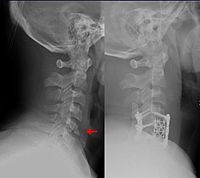
Photo from wikipedia
Abstract Rationale, aims, and objectives Studies suggest that routine radiographs during follow‐up of distal radius and ankle fractures result in increased radiation exposure and health care costs, without influencing treatment… Click to show full abstract
Abstract Rationale, aims, and objectives Studies suggest that routine radiographs during follow‐up of distal radius and ankle fractures result in increased radiation exposure and health care costs, without influencing treatment strategies. Encouraging clinicians to omit these routine radiographs is challenging, and little is known about barriers and facilitators that influence this omission. Therefore, this study aims to identify barriers and facilitators among orthopaedic trauma surgeons that might prove valuable towards the design of a deimplementation strategy. Methods A mixed‐method approach was used. First, interviews were conducted with orthopaedic trauma surgeons and patients (n = 16). Subsequently, a questionnaire was developed. This questionnaire was presented to 228 orthopaedic trauma surgeons in the Netherlands. Regression analyses were performed in order to identify which variables were independently associated to the decision to stop performing routine radiographs 6 and 12 weeks after trauma if proven not effective in a large randomized controlled trial. Results In total, 130 (57%) respondents completed the questionnaire. Of these, 71% indicated they would stop ordering routine radiographs if they were proven not effective. Three facilitators were independent predictors for the intention to omit routine radiographs: This will “lead to lower health care costs” (Odds Ratio [OR]: 5.38 and 4.38), the need for “incorporation in the regional protocol” (OR: 3.66 and 2.66), and this will “result in time savings for the patient” (OR: 4.84). Conclusions We identified three facilitators that could provide backing for a deimplementation strategy aimed at a reduction of routine radiographs for patients with distal radius and ankle fractures.
Journal Title: Journal of Evaluation in Clinical Practice
Year Published: 2019
Link to full text (if available)
Share on Social Media: Sign Up to like & get
recommendations!